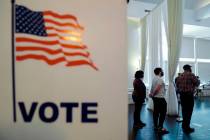BLM says wild horse and burro herds grew and so did management problem
More than 67,000 wild horses and burros now roam public land across the West, an increase of 15 percent from last year, according to estimates released Wednesday by the Bureau of Land Management.
That is more than double the number of animals recommended under the agency’s own appropriate management levels, which call for no more than 26,715 horses and burros across 10 states.
Nevada is home to almost 60 percent of the estimated 55,311 horses living in the wild as of March 1, the BLM said. The wild burro population across the West was 11,716, including 2,552 in Nevada, according to the estimates.
Steady population growth and an ongoing decline in adoptions has led to funding and operational problems for the federal agency charged with protecting the wild herds.
BLM Director Neil Kornze said his agency has doubled what it spends on horse and burro management over the past seven years, but the population continues to grow both in the wild and in off-range holding facilities, which house some 46,000 animals.
At almost $50,000 per horse, the lifetime cost of caring for the current captive population could top more than $1 billion, BLM officials said.
“A number of program reforms are underway, but assistance is needed from our local, state, and federal partners,” Kornze said.
Last month, Gov. Brian Sandoval said he would pursue legal action to force the federal government to fund efforts to curb state’s wild horse population.
Sandoval’s threat came after the BLM told some Nevada livestock producers to expect the reduction or elimination of grazing permits because of poor range conditions the agency blamed on wild horses.
Steps being taken include a government-sponsored research program focused on fertility control, the transfer of horses from off-range corrals to cheaper pastures, and the launch of new programs and partnerships to boost adoptions.
The BLM is also seeking congressional approval to transfer horses to other agencies that need work animals and to create a foundation for funding and supporting adoption efforts.
Over the past 15 years, wild horse adoptions have dropped from about 8,000 a year to about 2,500, according to the bureau.
But one horse advocacy group is blasting the suggestion that federal range land is overpopulated with the animals.
“We don’t have an excess wild horse problem, we have a federal mismanagement problem,” Suzanne Roy, executive director of the American Wild Horse Preservation Campaign, said in a statement. “The BLM’s claims of wild horse overpopulation are grossly exaggerated and designed to dupe the public into accepting the continued costly, cruel and unsustainable roundup, removal and stockpiling program.”
Instead of roundups, the group wants the BLM to — among other ideas — expand the use of fertility control drugs and develop a process for ranchers to voluntarily suspend or retire their livestock grazing permits in wild horse and burro management areas.
Advocates argue that it would be far cheaper to compensate ranchers than to continue to gather and warehouse thousands of wild horses.
BLM estimates the wild horse and burro population grew by 18 percent from 2014 to 2015. Agency officials said wild herds usually double in size every four years.
The bureau plans to remove 3,500 wild horses and burros from public land in 2016.
Contact Henry Brean at hbrean@reviewjournal.com or 702-383-0350. Find@RefriedBrean on Twitter.




























